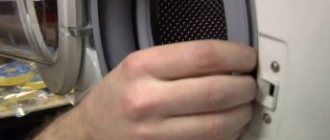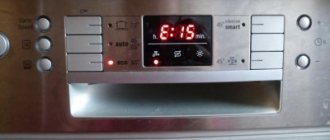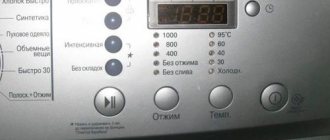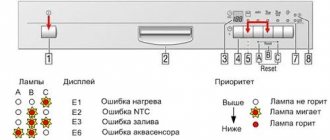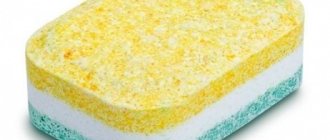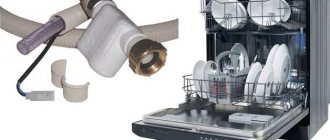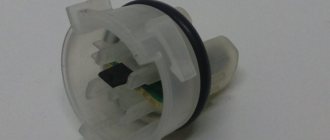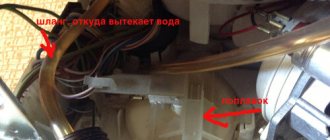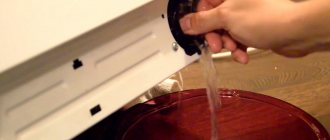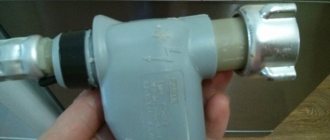- home
- Articles
- Dishwasher hums
Extraneous sounds during operation of household appliances indicate breakdown or improper operation. Sometimes they can be eliminated by tuning and adjusting the unit, but more often they require the intervention of a specialist. When the dishwasher hums during operation, this may be a sign of wear and tear on parts and components. If they are detected in a timely manner and replaced with new ones, this will extend the life of the unit by several years.
Why did the dishwasher start humming?
After turning on the device, is there any noise or, on the contrary, complete silence? There may be reasons for this:
- When turned on, the machine hums and does not draw water. Check if there is water in the tap. Turn the shut-off valve: it may have been accidentally closed.
- Press the hopper door harder. If the door is open, the cycle will not start and water will not flow into the chamber. This was done to protect against leaks. The computer may hum but not work, or squeal while working.
- The inlet hose is kinked or clogged. Check that the hose is connected correctly: it should be straight and without kinks. Disconnect it from the housing and inspect for blockages.
- If the appliance starts to buzz during operation, check the installation of the machine, as well as the location of the dishes in the baskets.
The causes of the most severe breakdowns, when the machine hums, creaks, but does not work, are:
- drain pump failure;
- pump bearing wear;
- circulation pump failure;
- intake valve malfunction.
If the noise level increases, immediately unplug the PMM and continue testing.
How to troubleshoot
If the PMM makes a loud sound, first of all you need to check the correct installation and inspect parts that may have become clogged during operation.
Sprayer and impeller
You can clean these parts yourself. For this:
- Open the switched off machine and remove the dish basket.
- Wash the removed nozzles and clean the nozzles.
- Unscrew the drain filter and rinse the removed mesh thoroughly.
Important! To extend the life of the machine, dirt should be removed from the nozzles and impeller regularly.
If hard objects or broken dishes get into the impeller, a loud noise will be heard or the machine will not work at all. To check the pump impeller, it is necessary to dry the filter seat. Next, with a slight movement, pull the flap to the side and towards you. Rinse the removed part under running water.
Dirt can be removed with a toothpick
Intake valve
The machine makes a loud noise when filling with water. This problem occurs when the filling valve is faulty. This part is located at the bottom of the case and can be replaced at home. Simply unscrew the screws and disconnect the wiring.
Pump bearing
With constant operation, bearings quickly fail (2-3 years). If the PMM begins to make a loud noise when draining water, then it is necessary to begin repairs.
What is needed for this:
- Turn off the machine and remove the dish basket.
- Remove the drain filter and unscrew the screws located around it.
- Remove the tray from the dishwasher (if it has one), loosen the clamps, disconnect the pipes and hoses from the unit.
- Disconnect the wiring and lift the block up and remove it from the hooks.
After simple manipulation, you can disassemble the circulation pump. For this:
- Disconnect the heating unit, remove the armature and impeller.
- Remove the bearing and rubber.
- If parts are worn out, they must be replaced.
Assembly is carried out in reverse order.
A new circulation pump can be replaced at home
Drain pump
If, after replacing worn parts, the PMM begins to hum again, then it is necessary to inspect the drain pump and replace the pump. After disassembling the PMM, disconnect the drain pump from the block and check the resistance using a multimeter. If it is normal, then you should check each mechanism; if not, then you should replace the pump with a new one.
To avoid blockages and prolong the performance of equipment, it is important to follow simple rules:
- Before loading, clean the dishes from food residues;
- the bunker cannot be reloaded;
- use high-quality detergents;
- After each wash, clean the filters.
A dishwasher is a reliable assistant in the home. In order for it to serve for a long time, it is necessary to follow the operating rules. Housewives often encounter that the dishwasher hums while filling or draining. If this happens, repairs must be started immediately.
Subscribe to TechnoCouncil on social networks so you don’t miss anything:
Dishwasher hums during operation
The main reason why the dishwasher hums when washing is a malfunction of the circulation pump. It is connected to the drain pump and is responsible for recirculating liquid in the unit during the wash cycle. There is a bearing that wears out over time. At the same time, the pump makes a lot of noise. In such a situation, it will be useful to replace the bearing. If this is not done in time, the pump itself may fail or damage nearby parts.
A buzzing sound may occur if the control unit is faulty. Multiple processes can be running simultaneously. If there are no visible problems with water circulation when washing dishes, it is necessary to diagnose the control unit.
Prevention measures
Most often, humming and humming in household appliances is associated with its improper installation, operation and maintenance. The dishwasher is installed in the same way as a washing machine - level, with adjustable legs. It should not be warped, the door should open completely and close without problems. If this is not the case, adjust its position.
Always load the basket with dishes as recommended by the manufacturer. The utensils should not touch the walls or touch the sprinklers. You should also not overload the baskets.
After washing, it is advisable to clean the drain filter. This is not difficult to do: it is easy to get out without additional tools. It is worth using dishwasher cleaning products - such household chemicals are available in all stores.
If, despite all preventive measures, the dishwasher pump hums during operation, you need to call a repairman for diagnostics. If you replace one part in time, you won’t have to buy new equipment.
Reasons for the loud noise of the dishwasher when filling with water
A loud hum when the dishwasher is turned on is most often associated with a problem with the water supply. Common causes of loud noise include the following:
- Fine and coarse filters are clogged. Leftover food on dishes causes blockages, resulting in poor water flow into the sprinkler. The ingress of grain residues (rice, buckwheat, etc.) and fruit seeds can also interfere with the rotation of the impeller or cause damage to its blades.
- Weak water pressure. Insufficient pressure in the water supply can cause a humming noise when starting the machine.
- Kinked or dirty water supply hose.
- Incorrect loading of dishes or foreign objects.
- Improper installation of the dishwasher causes vibrations and a loud hum when the device operates.
The above causes of malfunctions in the dishwasher can be easily eliminated without the need for special skills. However, loud noise when filling the dishwasher with water can be caused by more serious defects:
- failure of the drainage pump;
- circulation pump bearing wear;
- intake valve malfunction.
If you suspect that your dishwasher is not working properly, corrective action must be taken immediately. Failure to do so may cause serious damage to the device.
Water inlet valve
The water supply valve consists of a diaphragm that is controlled electronically to ensure proper water flow to the dishwasher. Over time, the membrane can become deformed and the water flow pattern can change, which can cause strange sounds. If noise occurs while the machine is filling with water, it likely indicates an inlet valve problem. The most common sound heard is a buzzing or squealing sound, but sometimes a loud vibration may occur.
Information was provided by our friends from https://servis-tehnik.ru/remont-posudomoechnyh-mashin/
You will help promote the project - “Large Family” by sharing the article with your friends:
Very noisy when washing
Some dishwashers are equipped with electronic controls, which have an electrical switching device on the panel that is driven by a motor. The motor may cause grinding sounds when the dishwasher is running. This is normal and not a cause for concern.
However, if your dishwasher is humming and suddenly starts squealing, open the dishwasher door mid-cycle, wait for the steam to dissipate, pull out the bottom rack, and check to see if anything is stuck around the drain wheel (the spinning plastic blades). If the sound continues, remove the impeller and check the impeller area for debris.
Check if any object is stuck around the drain wheel
What noise is normal?
The dishwasher always makes certain sounds when operating. Their values in normal mode range from 35 to 50 dB. If the maximum value is exceeded, it becomes uncomfortable to be in the same room with equipment. In this case, you need to check why the dishwasher is humming and eliminate the source of the extraneous noise. Normally, the nature of the hum is similar to the barely audible operation of a pump.
How to check and restore your dishwasher yourself
You can install and remove the source of strong noise in the dishwasher yourself, without the involvement of specialists.
First you need to check the simplest causes of malfunctions: the presence of debris, low (high) pressure in the pipes, kinks in the hose. To do this, you need to clean the machine by thoroughly rinsing the contaminated parts under running water, lay the hose correctly, or increase the pressure in the water supply with a pump. To resolve more serious problems, we suggest using the advice of experienced professionals - they will help you easily restore the functionality of your kitchen assistant. Important condition:
- it is necessary to strictly follow the instructions to eliminate breakdowns in one or another part of the device.
Sources
- https://cosmo-frost.ru/posudomoechnye-mashiny/neispravnosti/pochemu-gudit-posudomoechnaya-mashina-kak-ispravit/
- https://inventori-steam.ru/elektrika-drugoe/shum-v-posudomoechnoj-mashine.html
- https://setafi.com/bytovaya-tehnika/posudomojka/posudomojka-gromko-shumit-pri-nabore-vody/
- https://technosovet.ru/dlya-chistoty-i-byta/posudomoechnaya-mashina/pochemu-gudit-i-chto-delat
- https://grand-electro.ru/vopros-otvet/posudomoyka-gromko-shumit-pri-nabore-vody.html
- https://make-a-choice.ru/pochemu-gudit-posudomoechnaya-mashina-pri-myte/
Drainage pump
It happens that checking the pump for the cause of a machine breakdown gives a negative result. If a hum occurs when water is being discharged, then the problem is in the drainage pump, a spare part responsible for the drainage after the end of the cycle. The dishwasher squeaks due to increased load on the drain. The equipment is operating at the limit of its capabilities and cannot complete the cycle normally. If, under other conditions, the machine does not make any extraneous sounds, then you will have to disassemble the pump to find out the causes of problems in the mechanisms.
You can remove the pump by placing the dishwasher on its side and unscrewing the tray. The pump is held in place using seals on the clamps. The main thing in this matter is not to lose the pump and seals, as important components for a dishwasher.
Most likely, the issue is a malfunction of the impeller. Dismantle it immediately. Then install a new one. Now the pump will work as before. The main thing is to follow the correct procedure for returning the dishwasher. The system is now updated and will work even better than before.
However, there is a more reliable option: replace the entire pump. This spare part is inexpensive, so do not worry about the possibility that you will have to change the entire pump.
Technical problems
Are the communications all right, but the water isn’t getting filled? We will look for technical reasons for the problems. The most common breakdowns:
- door lock malfunction;
- clogged filter (flow);
- breakdown of the Aquastop system;
- damage to the water supply valve;
- feed sensor error;
- "glitch" in the control module.
Lock violation
If the lock is broken, the pump does not pump liquid into the chamber, so the leakage protection is activated. What to do? Change the lock.
For this:
- unplug the dishwasher;
- open the door;
- unscrew the front panel;
- unscrew the broken lock;
- install a new one;
- assemble the door.
In-line filter clogged
The filter cleans the PMM from debris that can enter the system from the water supply. Over time, dirt accumulates. The filter needs regular cleaning or cartridge replacement. If there is no water flow or low pressure, remember the last time you cleaned the filter?
"Aquastop"
This is a special solenoid valve that shuts off the pressure during a leak. To correct the situation, eliminate the leak and change the intake hose.
Supply valve (inlet)
If you can hear the pump running and humming, but does not pump, most likely the inlet valve is damaged by strong pressure (more than 1 MPa) or clogged. The blockage can be eliminated, but it is better to replace the damaged spare part, since it cannot be repaired.
Level sensor
When the sensor does not respond, the tank overflows, emergency mode is activated, and the pump begins to intensively pump out liquid. There is little water left in the chamber and the washing process does not start. Sensor check:
- turn the dishwasher over;
- remove the pan;
- inspect the sensor for defects;
- “ring” with a multimeter;
- no voltage - replace the faulty part.
Control module defect
The PMM “command center” is located in the door, under the front panel. This is the “brain” of the dishwasher, which sends commands to the systems and monitors compliance with the algorithm of washing modes. If even a small section of the board is damaged, it does not send signals, and the program crashes. As a result, the machine does not pour water.
To check the module, you should disassemble the door, as in the case of a lock. Conduct a visual inspection of the board for deformations, scorches, rust, and other damage. The faulty module can be replaced with a new one suitable for your model.
Now you know why water does not fill into the dishwasher chamber. Remember, if the PMM is under warranty, it is easier and cheaper to turn to professionals.
Drainage pump
For example, we checked the circulation pump and made sure that it was not the problem, then why is the dishwasher humming? The answer to this question should be sought somewhere in the area of the drainage pump. It is not at all difficult to understand that the cause of the problem lies precisely in the pump. Listen to the point at which the dishwasher starts making an unpleasant sound. If this happens exclusively when the "home assistant" is discharging waste water, 99% of the reason is in the sump pump. Let's take it off.
- We remove everything unnecessary from the dishwasher, including remaining water.
- Turn off the machine.
- Place the dishwasher on its side.
- We dismantle the pallet.
- Unhook the hose from the pump by loosening the clamp.
- Disconnect the electrical wiring.
- Unscrew the screws holding the part and remove the pump.
Next we need to disassemble the pump itself and find out the reason for this hum.
Pay special attention to the impeller. If it is deformed, then it is better to replace it, or better not to bother and change the entire pump
This part is inexpensive; in principle, it is not worth repairing.
Having installed a new pump, we assemble the machine in reverse order and use the updated dishwasher, which will no longer bother you with a disgusting and intrusive hum
When assembling and disassembling dishwasher parts, be careful and then everything will be fine. Good luck!
Interesting:
- How to replace the circulation pump in a dishwasher
- Bosch dishwasher errors
- The dishwasher doesn't wash the dishes - we fix it ourselves
- How to replace a dishwasher pump
- Miele dishwasher errors
- How a dishwasher works (basic principles)
Reader comments
Share your opinion - leave a comment
Damage to the pressure switch level sensor
If water does not flow into the dishwasher, you need to adjust the water supply level and send a signal to the board that produces the machine's pressure switch. This part is equipped with a liquid volume level sensor in the chamber. Due to its multi-functionality, the washing program requires different volumes of liquid. A pressure switch is provided for the automated washing program and to control the filling of the required amount of water into the chamber.
Dishwashers are equipped with two types of pressure switch:
- Mechanical - in this type the membrane fails.
- Electronic is a complex device where it is possible to determine the breakdown only using a tester with an error code recognition program.
There are characteristic signs of a malfunctioning pressure switch. For example, when liquid is supplied to the system, liquid is overfilled or underfilled into the chamber. After filling the tank with water, it is drained, the equipment stops working with a full tank, and the drain does not pump out water. The reason may be:
- sensor element failure;
- the contacts are weakly fixed, which causes an increase in the temperature of the wiring;
- The pressure hose is clogged due to debris.
Work must be carried out in the following order:
- Disconnect the equipment from the power supply and water supply system.
- Install the soft stop and turn it over to the back.
- Unscrew the screws and unfasten the latches of the bottom cover.
- Using pliers, disconnect the tube from the camera and inspect for any blockages.
It is not difficult to diagnose the mechanical part of the sensor: you need to blow into the pressure sampling tube, clicks should be heard from the pressure switch. This means that the switch has actuated and the device is in working order.
The electronic one is checked with a multimeter. To do this, you need to connect the probes to the contacts; if the reading is zero, the pressure switch is working properly. If there is a malfunction, the sensor should be replaced. To do this, you need to disconnect the tube and contacts.

